What is the state of food trade in South Asia?
A recent study by IFPRI assessed food trade among and across the SAARC, ASEAN and China markets. Trade levels were quantified using a gravity model, which estimated predicted trade against actual trade for the period 1996 – 2016. The results show that more country pairs under export than over export. In particular, subpar trade exists for Bangladesh, the Philippines, Sri Lanka and Viet Nam, who under export to China as well as nearly all ASEAN and SAARC countries, varying between 40 – 100% below predicted levels. China’s trading to ASEAN countries is largely in line with predicted levels, but even China under-exports to SAARC countries by 60 – 80%. In general, SAARC countries tend to be under-exporting in food products to a greater degree than ASEAN countries. Over trading is also true for some countries.
In trying to understand the reasons for under exporting, it appears that tariffs adversely affect agricultural exports, reducing the magnitude of under-exporting of ASEAN and SAARC countries by 1% and 3% respectively. ASEAN countries apply more non-tariff measures (NTM; policy measures other than ordinary customs tariffs) on agricultural imports compared to SAARC countries. Additionally, there are many unobservable factors such as high levels of informal trade and trust deficits which likely explain some of the subpar trading between countries. Informal trade occurs between countries but is not included in official statistics; high levels of informal trade (for example 50% for South Asian countries according to this report by the ADB) provides indirect evidence of trade potential. Informal trade is prompted by high tariffs, stringent NTMs, distorted domestic policies, and other non-economic and institutional factors. Lack of trust between countries can affect trade flows, and this is particularly relevant for South Asia where a complicated political history, conflict, and size differences contribute to low levels of trust.
Food trade in the ASEAN region is more open (8.45%) compared to the SAARC region (2.82%); this is also true for trade in general. The top three partners in exports and imports for ASEAN countries are other ASEAN members, China, India and Japan, all of whom have free trade agreements with ASEAN. For SAARC countries, the top trading partners are all non-SAARC countries, even though there has been a South Asian Free Trade Area since 2006.
More open trade is seen as desirable because it allows access to larger markets, opportunities for specialisation in production, and creates gains from economies of scale, technology transfers and knowledge spill over. For food trade in particular, openness can also lead to an increase in the total amount and variety of food that is available, at lower prices. A previous report by The Asia Foundation highlighted the importance of the regional rice trade in cushioning against weather shocks across South Asia, with a surplus Indian market allowing South Asian importers to contain inflation at home. Increasing regional trade, including through improved trade facilitation measures and lowering the cost of trade by achieving stability in tariff rates, can have important positive implications for food security in South Asia.
The full report can be downloaded here. For more information, please contact Avinash Kishore ([email protected]).
